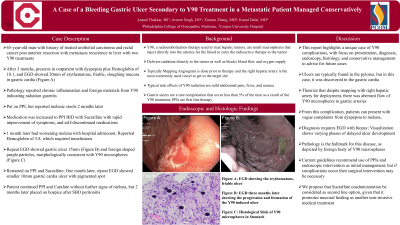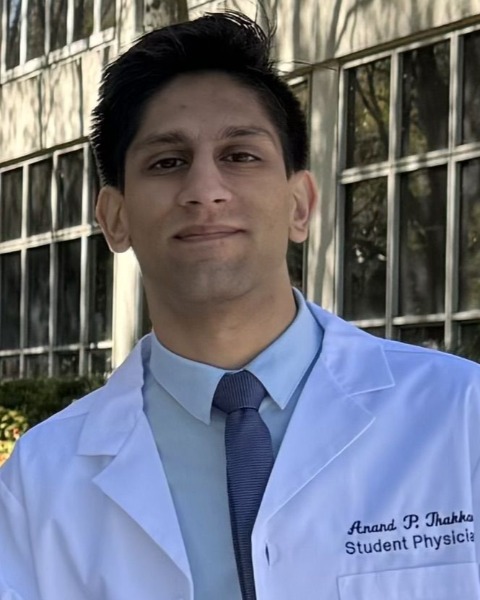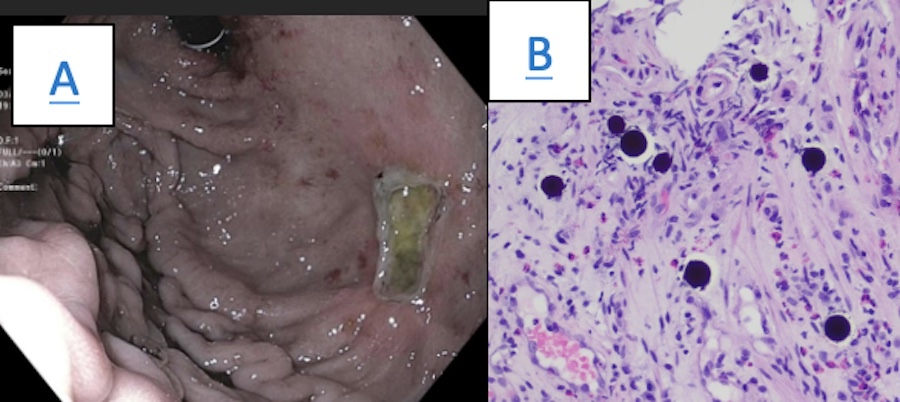Sunday Poster Session
Category: GI Bleeding
P0811 - A Case of a Bleeding Gastric Ulcer Secondary to Y90 Treatment in a Metastatic Patient Managed Conservatively
Sunday, October 27, 2024
3:30 PM - 7:00 PM ET
Location: Exhibit Hall E

Has Audio

Anand P. Thakkar, BS
Philadelphia College of Osteopathic Medicine
Linwood, NJ
Presenting Author(s)
Anand Thakkar, BS1, Kunal Dalal, MD2, Xinmin Zhang, MD2, Avneet Singh, DO2
1Philadelphia College of Osteopathic Medicine, Linwood, NJ; 2Cooper University Hospital, Camden, NJ
Introduction: Yttrium-90 (Y90) radioembolization is commonly used to treat hepatic tumors. With the increased use of
this technique a relatively rare complication occurring less than 5% is a gastric ulcer. Here we report a
case of Y90 induced gastric ulcer with a focus on presentation, endoscopy, and management to advise
for future cases.
Case Description/Methods: A 65 year old male with a history of treated urothelial carcinoma and rectal cancer s/p lower anterior
resection with metastasis recurrence to liver with two Y90 treatments presents outpatient 3 months
later for dyspepsia with hemoglobin (Hgb) of 10.1. He underwent EGD showing 20 mm of erythematous,
friable, sloughing mucosa in the gastric cardia which was biopsied. Pathology reported chronic
inflammation and foreign materials from Y90 representing radiation gastritis. He was subsequently
placed on PPI daily, but reported melenic stools 2 months later. Medication was increased to PPI BID
and sucralfate was added. He had rapid improvement of symptoms and self-discontinued medications,
then 1 month later had worsening melena with hospital admission with Hgb 5.8 requiring transfusions.
Repeat EGD showed a gastric cardia ulcer 15 mm (Figure A), and foreign spherical shaped purple
particles, morphologically consistent with Y90 radio-embolization microspheres, were found, as
illustrated in Figure B. He was restarted on PPI and sucralfate. One month later, repeat EGD showed
smaller 10 mm gastric cardia ulcer with pigmented spot. The patient continued PPI and carafate without
further signs of melena, but ultimately was placed on hospice 2 months later after SBO peritonitis.
Discussion: Most Y90 gastric ulcers occur near the pylorus, but this ulcer was noted in the gastric cardia. We
theorize despite mapping with right hepatic artery for deployment, there was aberrant flow of Y90
microspheres to gastric arteries. Patients can present with varying complaints from dyspepsia to
melena. Diagnosis requires direct visualization which show varying phases of delayed ulcer
development, but all pathology with foreign body of Y90 microspheres. There is no management
guideline, but generally patients are treated with PPIs with complications requiring invasive
interventions. Specifically, we propose sucralfate coadministration is currently underutilized and may
promote healing for this ulcer. This case highlights the presentation, diagnosis, and conservative
management of rare Y90 ulcers.

Disclosures:
Anand Thakkar, BS1, Kunal Dalal, MD2, Xinmin Zhang, MD2, Avneet Singh, DO2. P0811 - A Case of a Bleeding Gastric Ulcer Secondary to Y90 Treatment in a Metastatic Patient Managed Conservatively, ACG 2024 Annual Scientific Meeting Abstracts. Philadelphia, PA: American College of Gastroenterology.
1Philadelphia College of Osteopathic Medicine, Linwood, NJ; 2Cooper University Hospital, Camden, NJ
Introduction: Yttrium-90 (Y90) radioembolization is commonly used to treat hepatic tumors. With the increased use of
this technique a relatively rare complication occurring less than 5% is a gastric ulcer. Here we report a
case of Y90 induced gastric ulcer with a focus on presentation, endoscopy, and management to advise
for future cases.
Case Description/Methods: A 65 year old male with a history of treated urothelial carcinoma and rectal cancer s/p lower anterior
resection with metastasis recurrence to liver with two Y90 treatments presents outpatient 3 months
later for dyspepsia with hemoglobin (Hgb) of 10.1. He underwent EGD showing 20 mm of erythematous,
friable, sloughing mucosa in the gastric cardia which was biopsied. Pathology reported chronic
inflammation and foreign materials from Y90 representing radiation gastritis. He was subsequently
placed on PPI daily, but reported melenic stools 2 months later. Medication was increased to PPI BID
and sucralfate was added. He had rapid improvement of symptoms and self-discontinued medications,
then 1 month later had worsening melena with hospital admission with Hgb 5.8 requiring transfusions.
Repeat EGD showed a gastric cardia ulcer 15 mm (Figure A), and foreign spherical shaped purple
particles, morphologically consistent with Y90 radio-embolization microspheres, were found, as
illustrated in Figure B. He was restarted on PPI and sucralfate. One month later, repeat EGD showed
smaller 10 mm gastric cardia ulcer with pigmented spot. The patient continued PPI and carafate without
further signs of melena, but ultimately was placed on hospice 2 months later after SBO peritonitis.
Discussion: Most Y90 gastric ulcers occur near the pylorus, but this ulcer was noted in the gastric cardia. We
theorize despite mapping with right hepatic artery for deployment, there was aberrant flow of Y90
microspheres to gastric arteries. Patients can present with varying complaints from dyspepsia to
melena. Diagnosis requires direct visualization which show varying phases of delayed ulcer
development, but all pathology with foreign body of Y90 microspheres. There is no management
guideline, but generally patients are treated with PPIs with complications requiring invasive
interventions. Specifically, we propose sucralfate coadministration is currently underutilized and may
promote healing for this ulcer. This case highlights the presentation, diagnosis, and conservative
management of rare Y90 ulcers.

Figure: A: EGD showing the Y90 induced ulcer in the Cardia of Stomach
B: Histological slide of Y90 microspheres in Stomach
B: Histological slide of Y90 microspheres in Stomach
Disclosures:
Anand Thakkar indicated no relevant financial relationships.
Kunal Dalal indicated no relevant financial relationships.
Xinmin Zhang indicated no relevant financial relationships.
Avneet Singh indicated no relevant financial relationships.
Anand Thakkar, BS1, Kunal Dalal, MD2, Xinmin Zhang, MD2, Avneet Singh, DO2. P0811 - A Case of a Bleeding Gastric Ulcer Secondary to Y90 Treatment in a Metastatic Patient Managed Conservatively, ACG 2024 Annual Scientific Meeting Abstracts. Philadelphia, PA: American College of Gastroenterology.
